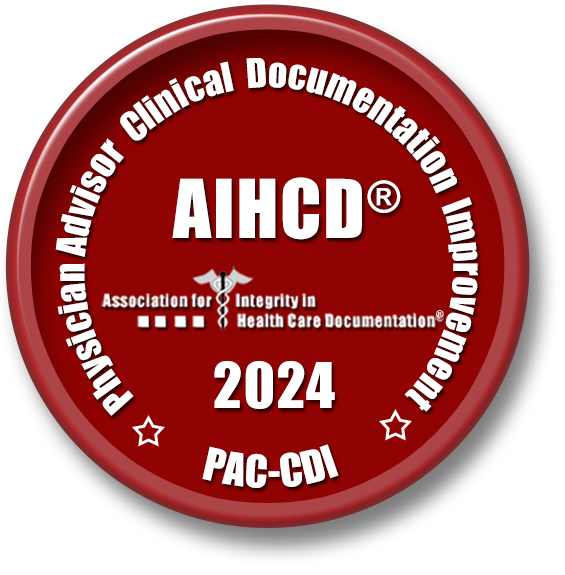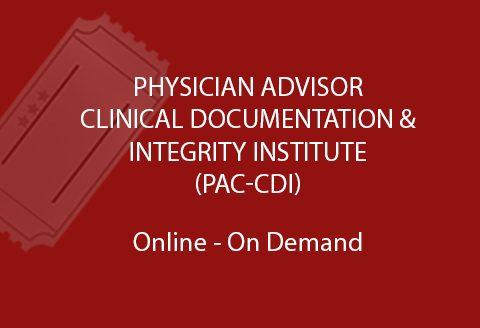
Physician Advisor Clinical Documentation &
Integrity Institute (PAC-CDI)
OVERVIEW
The Physician Advisor acts as a liaison to the Medical Staff for Case Management/Utilization Review operations and conducts clinical reviews on cases referred by Case Management (CM) staff and/or other healthcare professionals, in accordance with the hospital’s established Utilization Management (UM) Plan. The Physician Advisor meets the hospital objectives for assuring quality patient care and effective, efficient utilization of
Overall Program Learning Objectives:
• Define Medicare Conditions of Participation and the Utilization Review (UR) Committee
• Physician Advisor (PA) and the UR Committee involvement
• Chair, co-chair, educator or facilitator
• Extensive knowledge of Medical Necessity appropriateness
• Admission
• Continued stay
• Discharge parameters
• Understanding Severity of Illness (SI) and Intensity of Service (IS) Guidelines
• Identify and assist with compliant documentation of severity of illness as it relates to disease pathophysiology and acuity for the hospitalized patient
• Identify and demonstrate knowledge related to treatment modalities directly related to severity of illness and assist with the appropriate relationship between appropriateness of disease and standard treatment plans (for over-utilization and under-utilization of resources)
• Define an Inpatient Admission and help the Case Manager’s (CM) identify compliant physician documentation necessary for the inpatient admission
• Define an Outpatient Observation Service and identify hospitalized patients whose diagnosis and treatment plan meet medical necessity for outpatient observation services
• Define extended Post-Operative care not appropriate for observation services and assist the CM’s to determine appropriateness
• Condition Code 44
• When an inpatient admission for a Medicare beneficiary does not meet medical necessity for inpatient
admission and the attending physician agrees
• Physician to physician case reviews
• UR Committee decision
• Concurrent discussion of cases where care does not meet nationally recognized or facility supported standards of care
• Peer to Peer review to third party payers
• Physician discussion with the insurance companies is needed to medically support the level of care and treatment for an inpatient to prevent a potential denial
• Assisting with written appeal processes when required by the UR Committee
• Hospital Issued Notices of Non-Coverage
• Pre-Admission/Admission–Determination assisted by PA when SI and/or IS does not support patient ad mission
• HINN-10 (Hospital Requested Review)-Determined by PA support when IS is not met for continued stay and the attending does not agree
• HINN-12 (Continued Stay Review)-Determined with assist of the PA when attending refuses to discharge a patient that does not meet medical necessity for IS after HRR is returned by QIO
• Review of Medicare One Day Stays after discharge for Provider Liability
Attendees have the option of taking the Certification Exam within 6 weeks of this Program.
Payment/Substitutions/Cancellation
Registration accepted until seminar is full.
Registration Fee: $1,795
Physician Advisor Clinical Documentation & Integrity Certification Examination: $395
Total: $2190
For more information about our programs contact:
info@docucompllc.com
PAC-CDI AGENDA
The Role of Clinical Documentation Improvement and Integrity Specialists in the Transformation of Healthcare Reform and Reimbursement
Objectives:
• Communicate the evolution of the of the business of medicine from the perspective of reimbursement, beginning with the self-pay model, the third party payer reimbursement system and the strict business mod- el of medicine today followed by most payers today.
• Identify the roles pay-for-performance and medical necessity initiatives govern and directly impact all as- pects of medicine.
Session 2
MS-DRGs and the Segue to ICD-10
Objectives:
Explain the History of ICD, the development of version nine (9) and it’s affect of Clinical Modification
• Conceptualize the general principles and workings of ICD-9CM coding and its relationship to DRG assign- ment under the CMS DRGs and transition into MS-DRGS effective October 1, 2008.
• Apply general coding guidelines to case studies including recognition of principal and secondary diagnoses.
• Identify the resources for guidelines, regulatory policy, and medical necessity standards available to pro- viders and auditors as the tools for best practice for making appeals and denial basis.
• Specify the difference between Complications/Comorbidities and Major Complications/Comorbidities and
know the definition of each for DRG coding and reporting perspective.
• Explain the rationale for Medicare’s decision to implement Medicare Severity DRGS and the intended role of MS-DRGs in the Medicare Value Based Purchasing initiative implemented October 1, 2008.
• Compare the similarities and differences between the CMS DRG and MS-DRG system and the expansion of DRGs from 538 to 746 under MS-DRGs is an asset to best explaining variations in severity of illness, risk of mortality and morbidity, and measures of quality of care outcomes and physician efficiency measures.
Session 3
Outpatient Observation Service vs. Inpatient Designation – Documentation Requirements. What you need to know to stay on the right course.
Objectives:
• Delineate the differences between Outpatient Observation and Inpatient designation in the hospital
setting.
• Define what Medicare rules and regulations govern inpatient versus outpatient designation and billing.
• Identify what admission and discharge criteria govern observation versus inpatient designation.
• Explain the role of observation versus inpatient designation as a financial versus clinical tool.
• Apply general medical necessity criteria and guidelines to case studies including recognition of diagnoses, documentation, and specific clinical care information to support the patient status.
• Define and practically apply the documentation requirements for supporting a patient observation status.
• Summarize the Condition Code 44 – what it means to you and how to implement it appropriately.
• Identify the role of the Medicare Comprehensive Error Review Testing Contractor, Recovery Audit Con- tractors and their expansion, MACs assumption of MS-DRG validation and medical necessity determination from the QIO, and the OIG’s Work Plan, in reducing the hospital error rate in designating outpatient obser- vation versus inpatient admission encounters.
Session 4
RACs, CERTS, FIs, Quality Improvement Organizations, OIG Work Plans and Peer Review Organizations- What they are & where they are going.
Objective:
• Identify the goals, objectives, and focus of each organization, and how these are changing as value based purchasing, pay for performance, and quality outcome and efficiency initiatives take hold and become more prominent.
Session 5
Maintaining Relevance in Clinical Documentation Improvement and Integrity – A Business Perspective
Activities: Role playing from participant experiences within small groups.
• Define the role of the change agent in your facility including realistic expectations.
• Demonstrate how to become an effective change agent through sharing of knowledge gained in keeping up with and maintaining relevance in changing third party payment regulations with physicians and other staff in the hospital.
• Discuss strategies to overcome typical downfalls and other perils introduced through the hospital politi- cal environment, turning a negative into a positive.
Day 2
Session 6
Compliance, Fraud & Abuse and Clinical Documentation Improvement and Integrity
Objectives:
Discuss the legal consequences of fraud and abuse on healthcare providers and organizations.
• Explain the False Claims Act and the impact documentation errors can have on an organization.
• Communicate the other tools regulatory agencies use to enforce the regulations.
• Identify each of the 7 elements from the Federal Sentencing Guidelines.
• Discuss factors that demonstrate your organization’s commitment to the compliance process.
Session 7
The Hospital’s Perspective
Objectives:
• Explain the impact of today’s economy on the hospitals.
• Summarize the affects of Medicare Severity-DRGs (MS-DRGs) within the Inpatient Prospective Pay Sys- tem (IPPS).
• Identify Present on Admission (POA) and Hospital Acquired Conditions (HACs).
• Explain the impact of Physician Documentation and Coding on reimbursement.
• Explain the relationship between Hospitalists and improved efficiency in healthcare delivery.
Session 8
Communicating to MDs and Getting “Buy-in” Part 1
Objectives:
• Communicate the role of medical record documentation, its direct relationship to DRG assignment and application in administrative data, to promote physician buy-in of the Clinical Documentation Improvement and Integrity Program.
• Explain how explicit clinical documentation leads to more appropriate E & M level selections by physi- cians and allows these practitioners to more accurately communicate the true quality of care to third party payers.
• Outline to physicians how what they report today through medical record documentation, translated into administrative data through ICD-9 code assignment, will serve as Pay-for-Performance baseline measures for Medicare and other payers through initiatives such as Medicare Value Base Purchasing and Blue Cross Health Intelligence Programs.
• Identify and explain the role of medical record documentation to physician profiling, economic creden- tialing, adherence to clinical best practice guidelines & standards, and achievement of success & overcoming of challenges associated with the business of medicine in today’s increasing regulatory environment.
Session 9
Communicating to MDs and Getting “Buy-in” Part 2 – A Practical Approach Activities: Small group discussions of patient medical information
Session 10
How to Implement and Improve the Effectiveness of your Clinical
Documentation Improvement and Integrity Program: Bridging Medical Necessity and Clinical Documentation Improvement to Establish and Ensure Appropriateness Accuracy and Compliance
Objectives:
• Identify and explain the role of medical record documentation to physician profiling, economic credentialing, adherence to clinical best practice guidelines & standards, and achievement of success & overcoming of challenges associated with the business of medicine in today’s increasing regulatory environment.
• Develop structure and implement your Clinical Documentation Improvement and Integrity Program, taking into account the makeup of your medical staff, political process environment of the hospital, clinical coder competencies/skill sets, and overall strategic planning of the organization.
• Build strategies for Medicare important message compliance.
• Develop the skill set for screening for medical necessity, ensuring the appropriate level of care and properly crafting clinical queries without leading the physician to an improper answer. Discuss how to recognize when a clinical query is needed for clarification purposes.
• Provide strategies to minimize risk and reduce provider liability or loss of inpatient revenue.
• Build and expand upon time tested proven strategies that contribute to the development and implementation successes of Clinical Documentation Improvement and Integrity Programs.
• List pitfalls to avoid in the development and implementation phases of your program that will jeopardize the probability of success and buy-in from your medical staff.
• Effectively communicate with physicians teaching points for immediate and future clinical case studies. Discuss the basis for discussing succinct points with physicians, capitalizing upon the opportunity to present teaching points that stress the application of medical records documentation beyond claims data into administrative data.
Session 11
Medical Necessity and the Physician Advisor
Objectives:
• Discuss regulatory requirements
• Define Medical Necessity
• Explain Observation and its challenges
• Correlate the role of Physician Advisor to Medical Necessity
• Break
Session 12
The Role of the Physician Advisor: for Case Management and Clinical Documentation Improvement
Objectives:
• Prepare the physician for the role of Physician Advisor
• Define the Physician Advisor functions
• Describe the Utilization Review Committee
• Discuss the Physician Advisor’s role regarding Regulatory Compliance
Describe the collaboration of Physician Advisor with Case Manager and CDI
ACCREDITATIONS
THE ASSOCIATION FOR INTEGRITY IN HEALTH CARE DOCUMNTATION
This course has been approved by the Association for Integrity in Healthcare Documentation for 18 CEU contact hours. (AIHCD #21756)
Approval valid through 12/31/23
IS IT TIME TO RECERTIFY?
Pay Now


